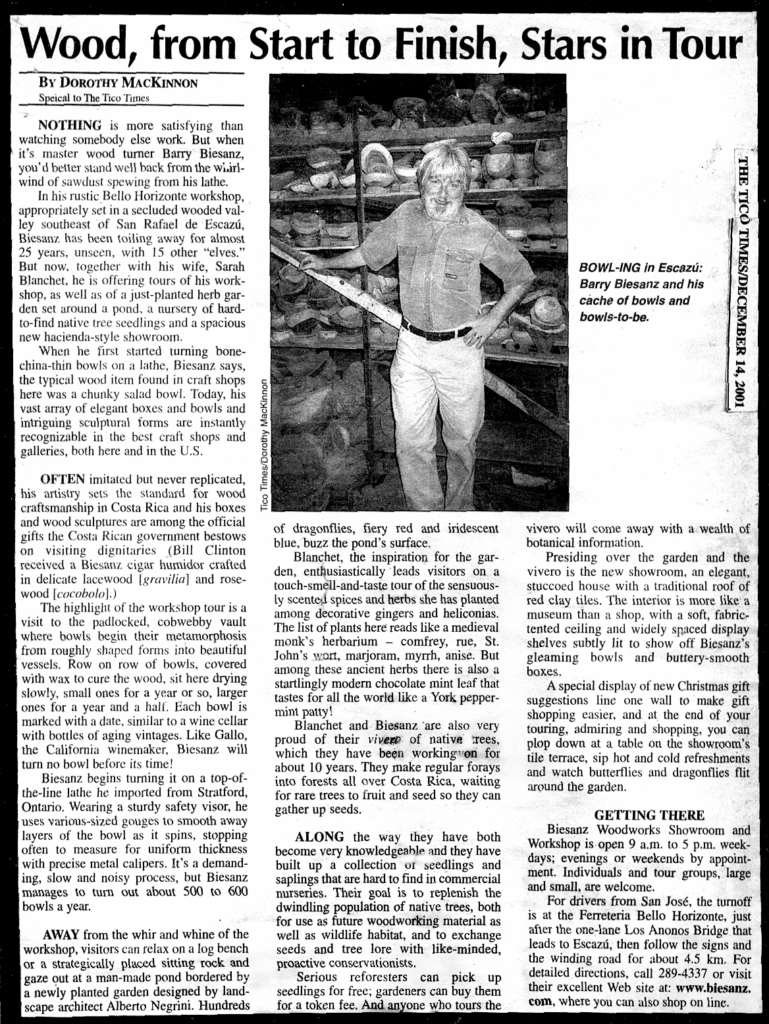Wood From Start to Finish Stars in Tour

Tico Times, December 14, 2001,
Wood From Start to Finish Stars in Tour
By Dorothy MacKinnon Special to the Tico Times
Nothing is more satisfying than watching somebody else work. But when it’s master woodturner Barry Biesanz, you had better stand well back from the whirlwind of sawdust spewing from his lathe.
In his rustic Bello Horizonte workshop, appropriately set in a secluded wooded valley southeast of San Rafael de Escazú, Biesanz has been toiling away for almost 25 years, unseen, with 15 other “elves.” But now, together with his wife, Sarah Blanchet, he is offering tours of his workshop, as well as of a just-planted herb garden set around a pond, a nursery of hard-to-find native tree seedlings and a spacious new hacienda-style showroom.
When he first started turning bone-china thin bowls on a lathe, Biesanz says, the typical wood item found in craft shops here was a chunky salad bowl. Today his vast array of elegant boxes and bowls and intriguing sculptural forms are instantly recognizable in the best craft shops and galleries, both here and in the US.
Often imitated but never replicated, his artistry sets the standard for wood craftsmanship in Costa Rica and his boxes and wood sculptures are among the official gifts the Costa Rican government bestows on visiting dignitaries (Bill Clinton received a Biesanz humidor crafted in delicate lacewood [gravilia] and rosewood [cocobolo].
The highlight of the workshop tour is a visit to the padlocked, cobwebby vault where bowls begin their metamorphosis from roughly shaped forms into beautiful vessels. Row on row of bowls, covered with wax to cure the wood, sit here drying slowly, small ones for a year or so, larger ones for a year and a half. Each bowl is marked with a date, similar to a wine cellar with bottles of aging vintages. Like Gallo, the California winemaker, Biesanz will turn no bowl before it’s time!
Biesanz begins turning it on a top-of-the-line lathe he imported from Stratford, Ontario. Wearing a sturdy safety visor, he uses various sized gauges to smooth away layers of the bowl as it spins, stopping often to measure for uniform thickness with precise metal calipers. It’s a demanding, slow and noisy process, but Biesanz manages to turn about 500 to 600 bowls a year.
Away from the whir and whine of the workshop, visitors can relax on a log bench or a strategically placed sitting rock and gaze out at a man-made pond bordered by a newly planted garden designed by landscape architect Alberto Negrini. Hundreds of dragonflies fiery red and iridescent blue buzz the pond’s surface.
Blanchet, the inspiration for the garden, enthusiastically leads visitors on a touch, smell, and taste tour of the sensuously scented spices and herbs she has planted among the decorative gingers and heliconias. The list of plants here reads like a medieval monk’s herbarium – comfrey, rue, St. John’s Wort, marjoram, myrrh, anise. But among these ancient herbs there is also a startlingly modern chocolate mint leaf that tastes for all the world like a York peppermint patty.
Blanchet and Biesanz are also very proud of their vivero of native trees which they have been working on for 10 years. They make regular forays into forests all over Costa Rica, waiting for rare trees to fruit and seed so they can gather up seeds.
Along the way they have both become very knowledgeable and they have built up a collection of seedlings and saplings that are hard to find in commercial nurseries. Their goal is to replenish the dwindling population of native trees both for use as future woodworking material as well as wildlife habitat and to exchange seed and tree lore with like-minded proactive conservationists.
Serious reforesters can pick up seedlings for free; gardeners can buy them for a token fee. And anyone who tours the vivero will come away with a wealth of botanical information.
Presiding over the garden and the vivero is the new showroom, an elegant, stuccoed house with a traditional roof of red clay tiles. The interior is more like a museum than a shop, with a soft, fabric tented ceiling and widely spaced display shelves subtly lit to show off Biesanz’ gleaming bowls and buttery smooth boxes.
A special display of new Christmas gift suggestions line one wall to make gift shopping easier, and at the end of your touring, admiring and shopping, you can plop down at a table on the showroom’s tile terrace, sip hot and cold refreshments and watch butterflies and dragonflies flit around the garden.
GETTING THERE
Biesanz Woodworks showroom and workshop is open 9am to 5pm weekdays; evenings or weekends by appointment. Individuals and tour groups large and small are welcome. For drivers from San José, the turnoff is at the Ferreteria Bello Horizonte, just after the one lane Los Anonos bridge that leads to Escazú, then follow the signs and the winding road for about 4.5 kilometers. For detailed directions call 289-4337 or visit their excellent website at http://www.biesanz.com, where you can also shop online.
